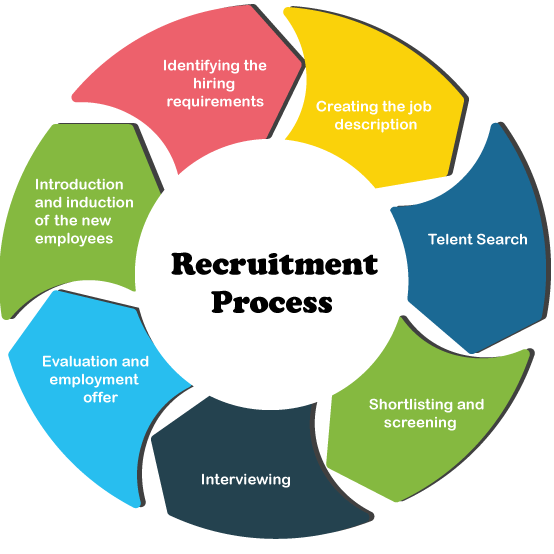Recruitment DefinitionSearching for potential workers and encouraging them to apply for positions inside the organization is a helpful procedure known as recruitment. When more individuals apply for jobs, the chance to hire better applicants increases. On the other hand, candidates looking for employment are also searching for employers. Recruitment is a networking activity that brings job seekers and job providers together. Simply said, the word "recruitment" refers to finding the source from which potential employees may be picked. This makes it a good practice since it encourages individuals to apply for employment. 
Reaching out, recruiting, and assuring a supply of skilled workers is what recruitment is all about. It also involves selecting the necessary people in both their qualitative and quantitative aspects. It involves the creation and upkeep of sufficient human resources. This is the initial step in the selection process, which is finished with placement. Several employees are in charge of recruiting, depending on the size of the company. A single recruiter may work for certain smaller businesses, while teams of recruiters may work for larger ones. In small businesses, recruiting may fall within the purview of the hiring manager. Also, a lot of businesses contract out their hiring to other businesses. Businesses virtually always use adverts, job boards, social networking sites, and other methods to find people for open positions. To find outstanding applicants more quickly and effectively, many businesses use recruitment software. In this case, recruitment frequently collaborates with or forms a component of human resources. DefinitionIt is a process of looking for potential workers and inspiring and motivating them to apply for positions in an organization, according to Edwin B. Flippo. He describes it in more detail, labeling it both negatively and positively. "It is frequently referred to as good in that it encourages individuals to apply for employment, increasing the hiring ratio, or the number of candidates for a position." In contrast, selection usually has a negative outcome since it leaves just the finest candidates for employment after rejecting a large portion of applicants. 
According to Dale Yoder, recruitment is the process of "discovering the sources of personnel to satisfy the requirements of the staffing schedule and also to utilize effective means for attracting that talent in enough numbers to permit successful selection of an efficient working force." According to Kempner, the process begins with recruitment, continues with selection, and ends with candidate placement. Management strives to do much more throughout the hiring process than only fill job positions. The regular procedure for hiring staff would be to fill the position with the first applicant who applies. According to Joseph J. Famularo, "however, the act of employing a man brings with it the expectation that he will stay with the company- that sooner or later his ability to execute his task, his capacity for career growth, and his capability to get along in the group in which he works would become matters of first significance." This calls for a critical evaluation of current recruiting practices, which is what this chapter sets out to do. Process of Recruitment
Factors Influencing RecruitmentAll businesses, no matter how big or small, must actively participate in hiring new employees. This process is influenced by a variety of things. 1. Size of Enterprise According to an enterprise's size, a certain number of people must be hired. A small business only employs a few people, but a large business frequently needs more people. A large company organization will keep in touch with potential suppliers and work to draw in more customers in order to make the best possible choice. It has the financial capacity to invest more money in identifying potential candidates. So, the recruiting process will be impacted by an organization's size. 2. Employment Conditions The hiring procedure is significantly impacted by the job condition in an economy. In developing economies, there are few employment opportunities, but there are plenty of skilled candidates. Yet, due to a shortage of educational and technological resources, qualified applicants might not be accessible. The choosing process becomes simpler when there are more people available. Also, it would be challenging to find competent individuals if there was a scarcity of technical experts. 3. Salary Structure and Working Conditions The number of available people is significantly influenced by the salaries provided and the working conditions present in an organization. The company won't have any trouble hiring if better pay is offered than at businesses of a comparable nature. The issue of high labor turnover may be experienced by a company that pays low salaries. The environment in which workers work will affect their level of job satisfaction. Employees would have more job satisfaction in a company that provides decent working conditions, such as clean restrooms, adequate lighting, and ventilation, and they might stay in their current positions. On the other hand, if workers quit their employment owing to poor working conditions, it will result in a new round of hiring. 4. Rate of Growth An organization's growth pace has an impact on the hiring process as well. An expanding company will need to hire new workers on a regular basis. Also, there will be promotions for current workers, which will make it necessary to fill those openings. Only when the current employee leaves his position due to retirement or another reason can a stagnant business hire new employees. Sources of Recruitment1. Internal Source of RecruitmentInternal recruiting sources are the current workers in a firm who are qualified to fill the position. Since they are drawn within the organization's skilled personnel, these candidates are much less expensive to recruit and easier to find. The employees in charge of human resources (HR) might educate the existing employee about the position's title, responsibilities, work history, and educational requirements. They typically communicate internally through phone, email, postings on bulletin boards, and websites. HR professionals frequently provide contact information and urge workers to apply so they may shortlist them for interviews. The following are some examples of internal recruiting practices in organizations: 
The company may give competent candidates a promotion to a higher-ranking position in the same or a different department, along with increased responsibility and pay. A promotion encourages workers to work more and produce more since it results in higher employment status and perks.
An employee may be transferred by the company from one department to another. A worker could also be moved to a branch office in a different city or nation.
An existing freelancer for the business can be given full-time employment. Also, it could hire previous workers who are retired or part-time or full-time applicants. 
The company may interview competent individuals and recommend them for open positions after screening current personnel. Bonuses or other incentives may be given to current workers for referring new people. 2. External Source of RecruitmentA collection of applicants from outside the organization who could be suitable for the open position are referred to as external recruiting sources. Organizations create a hiring budget to locate, evaluate, and interview applicants from diverse outside sources. In order to assist new hires, understand their roles and learn how to manage their workloads, organizations frequently provide orientation or training programs after acquiring new personnel. The following are some examples of external recruiting practices in businesses:
The company posts job openings via its website, social media platforms, business networking sites, employment sites, and newspapers. The job postings may be looking for recent graduates, mid-level employees, or senior-level personnel.
Qualified individuals may frequently take use of in-person and online job search assistance from the government as well as private sector employment agencies. These organizations may give the resume and interview advice in addition to advising individuals of open opportunities that match their skills and work experience.
There are several websites offering jobs from businesses in various industries. On these sites, users may make personal profiles, post their resumes, choose the kinds of jobs they're interested in, sign up for job notifications, and submit applications.
Businesses hold recruitment events at different colleges and universities to find final-year students for open positions. They could provide internships for the students prior to graduation and jobs thereafter.
Businesses in unionized sectors including hotels, construction, retail, textiles, finance, and insurance are allowed to hire new hires based on recommendations from labor unions.
Candidates may show up at the organization to inquire about open positions, whether they are skilled, semi-skilled, or unskilled. They could be hired by management based on their skills.
Certain businesses may have walk-in interview procedures that let qualified applicants apply without making a scheduled interview time. Importance of RecruitmentRecruitment is a crucial part of HR management since it guarantees that new hires are a great match for the company while also demonstrating the professionalism of the entire organization from the moment a potential hire wants to join. Recruitment is crucial for recruiting talented workers, ensuring cultural fit, saving time and money, boosting employee happiness, and preserving a strong brand image, among other benefits. I. Gain Skilled EmployeesHR managers can successfully ensure that they can hire talented workers throughout the recruiting process. This implies that companies will hire workers whose qualifications exactly fit their existing demands. Also, hiring gives businesses the chance to learn new talents that potential workers possess but that are now lacking inside the company. This is very important since hiring allows human resource management to flourish by assisting the organization in identifying talent that will be of great value to the entire organization. Also, by conducting recruiting procedures, an HR department may simply obtain the skills necessary to assist fill jobs in teams and guarantee that they aim for high productivity levels to accomplish desired results and work productively towards goals. II. Establishes Cultural FitThroughout the hiring process, HR managers may successfully make sure that the new hires are a good cultural match for the company. This specifically implies that HR experts may ensure and assess candidates' ability to successfully integrate into the company's culture throughout the recruiting and selection processes. For instance, if a candidate has a history of working in an environment where dependence on oneself is valued, HR may decide not to recruit them if the company's culture values teamwork and employee reliance on one another. As a result, HR managers must be aware of the recruiting goal and always make sure that they are focusing on choosing candidates who will fit into the organization's culture. Similarly, several HR professionals have thought of expressing the organizational culture inside the job description, allowing potential workers to assess whether or not they match the culture before applying. III. Saves Time and MoneyHR managers may successfully ensure that they are able to save company time and money through the recruiting process. In order to prevent spending money and time on searching for a replacement employee in the event that the new employee does not live up to expectations, HR managers will make sure to hire the proper candidate during the recruiting process who is best suited to satisfy organizational objectives. In order to do this, HR managers will carefully choose a candidate who possesses most, if not all, of the necessary talents for the position they are seeking. Also, by doing this, HR managers may lower the cost of educating staff members, as demonstrated by the fact that workers who already possess a number of necessary abilities don't require expensive training. Also, if a particular employee is unqualified for the position, HR managers may avoid the expense and effort of continuously training new hires. IV. Enhances Employee SatisfactionEmployee satisfaction levels may be significantly increased by paying attention to the recruiting process. In particular, prospective onboarding employees will be very happy with the company when HR managers try and ensure that the overall recruitment process is really simple and engaging for the potential employee. This is primarily because HR managers are aware that by providing a top-notch hiring process, they can fully satisfy the employee value proposition (EVP). Also, when highly talented employees enter a company and contribute greatly to the teams and other employees there, they are often able to raise the overall level of happiness among the rest of the workforce. Also, when candidates go through a very distinctive hiring process that guarantees to inspire candidates when they join the company by presenting prospective growth prospects, and candidates get what they were hoping for, there is a significant rise in employee satisfaction. V. Ensures Positive Brand ImageOne final key element in the significance of recruitment in HR management is the capacity of HR managers to maintain the retention and expansion of a positive brand image. The discussions they have during interviews on their perceptions of the company notably affect candidates who are learning about a company and truly have a good image of the organization. Similar to this, HR managers who take care to conduct a positive interview will not harm the company's reputation as a brand. The reputation of a business as having a great hiring process may also be built and strengthened by HR managers, encouraging staff to believe the firm is a great place to work for. HR professionals need to be aware of the importance of recruitment in HRM in order to keep up a successful recruitment process and generate positive brand views. In ConclusionDue to the increased competition in recruiting, several companies have created software to automate the hiring process, including recruitment management systems (RMSes) and applicant tracking systems (ATSes). In addition to many other advantages, these tools allow the talent acquisition team to streamline the application process, enhance the applicant experience, and use the systems for arranging interviews. To more rapidly discover possible applicants, evaluate strengths and shortcomings, and develop questions that might expedite the decision-making process, some firms are turning to screening technologies driven by artificial intelligence. Several businesses that have a significant number of high-turnover jobs have started processing applications using text messages sent to mobile devices, giving job seekers a far easier way to apply for vacant openings.
Next TopicRedox Reaction Definition
|
 For Videos Join Our Youtube Channel: Join Now
For Videos Join Our Youtube Channel: Join Now
Feedback
- Send your Feedback to [email protected]
Help Others, Please Share










